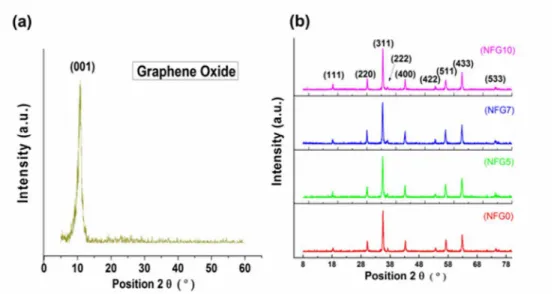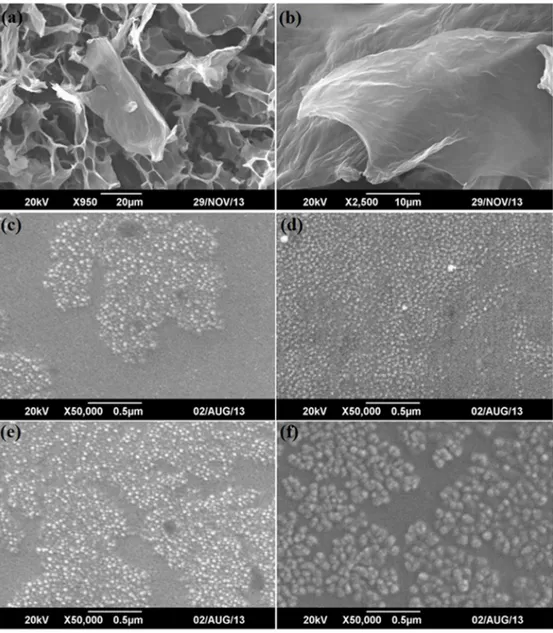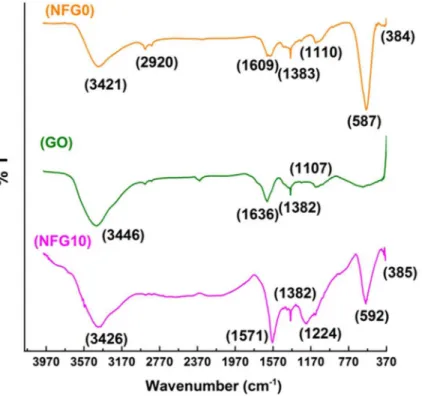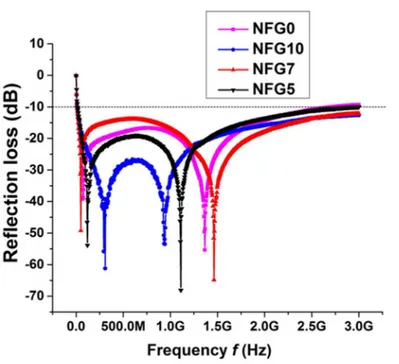Influence of Reduced Graphene Oxide on
Effective Absorption Bandwidth Shift of
Hybrid Absorbers
Shahid Ameer*, Iftikhar Hussain Gul
School of Chemical and Materials Engineering (SCME), National University of Sciences and Technology (NUST), H-12, Islamabad, Pakistan
*shahidameer@scme.nust.edu.pk
Abstract
The magnetic nanoparticle composite NiFe2O4has traditionally been studied for high-fre-quency microwave absorption with marginal performance towards low-frehigh-fre-quency radar bands (particularly L and S bands). Here, NiFe2O4nanoparticles and nanohybrids using large-diameter graphene oxide (GO) sheets are prepared via solvothermal synthesis for low-frequency wide bandwidth shielding (L and S radar bands). The synthesized materials were characterized using XRD, SEM, FTIR and microwave magneto dielectric spectroscopy. The dimension of these solvothermally synthesized pristine particles and hybrids lies within 30–58
nm. Microwave magneto-dielectric spectroscopy was performed in the low-frequency region in the 1 MHz-3 GHz spectrum. The as-synthesized pristine nanoparticles and hybrids were found to be highly absorbing for microwaves throughout the L and S radar bands (<−10 dB from 1 MHz to 3 GHz). This excellent microwave absorbing property induced by graphene sheet coupling shows application of these materials with absorption bandwidth which is tai-lored such that these could be used for low frequency. Previously, these were used for high frequency absorptions (typically>4 GHz) with limited selective bandwidth.
Introduction
The role of multifunctional materials as absorbers is significant in both antenna engineering and electromagnetic interference shielding/radar absorption. Several strategies have been used to minimize the effective radar cross section and decrease the reflection and emissions as well [1,2]. Surface engineering of aerospace structures is considered as an effective tool in reducing radar signatures besides other methods like structural shaping and active and passive loadings [1,3–5]. Radar-absorbing coatings have employed different kinds of materials like ceramics, polymers and polymer composites have a pivotal role in surface engineering of aerospace struc-tures [6,7].
Microwave absorber materials are characterized normally based on the absorption mecha-nism, i.e., dielectric absorbers, magnetic absorber and hybrid materials [8]. Dielectric absorber materials typically involve polymers and their composites, such as epoxy, olefin, polyester, PET
a11111
OPEN ACCESS
Citation:Ameer S, Gul IH (2016) Influence of Reduced Graphene Oxide on Effective Absorption Bandwidth Shift of Hybrid Absorbers. PLoS ONE 11 (6): e0153544. doi:10.1371/journal.pone.0153544
Editor:Oksana Ostroverkhova, Oregon State University, UNITED STATES
Received:July 30, 2015
Accepted:March 31, 2016
Published:June 7, 2016
Copyright:© 2016 Ameer, Gul. This is an open access article distributed under the terms of the
Creative Commons Attribution License, which permits unrestricted use, distribution, and reproduction in any medium, provided the original author and source are credited.
Data Availability Statement:All relevant data are within the paper and its Supporting Information files.
Funding:The authors have no support or funding to report.
and LLDPE filled with carbon fiber and MWCNTs, performed well in the high-frequency region extending from 4 to 18 GHz [1,2]. Magnetic absorbers typically involve hard and soft ferrites that are normally used in relatively high-frequency region as spinel-type ferrites show Snoek’s limit, and the magnetic loss decreases drastically at high gigahertz frequency [9].
Soft ferrites, especially NiFe2O4,have been widely studied for its high microwave absorption
[10]. Most of the studies involve the pristine NiFe2O4or its composite with rare earth elements;
polymers; carbon nanostructures, especially CNTs; and reduced graphene oxide (rGO) for high microwave frequencies (>4 GHz) [11,12]. Additionally, the major drawback of soft ferrite
such as NiFe2O4is its limited absorption bandwidth and selective absorption frequencies [13– 15]. Considering these issues, NiFe2O4nanoparticles were prepared via novel modified
sol-vothermal route and the influence of large-diameter rGO addition is analyzed by using in situ reduction and hybrid formulation utilizing the benefits of solvothermal treatment. Their mag-neto-dielectric properties were tailored with an aim to get high microwave absorption in the low-frequency region (mixed L and S bands) that can cover their entire bandwidth. Here, in this research work, NiFe2O4-rGO hybrid absorbers were prepared that showed excellent
micro-wave absorption in the low-frequency region covering the entire UHF/L/S bandwidth instead of selective frequency resonances.
Synthesis Procedure
Graphene oxide was used as a source of graphene sheets through modified solvothermal reduc-tion process. All the chemicals used as precursors at any stage were of AR grade. Graphene oxide was synthesized using a simplified Hummer method[16];typically 3g of flake graphite was mixed with 18g of KMnO4in 400ml acidic mixture (320ml:80ml H2SO4:H3PO4). The
reac-tion mixture was stirred rapidly and continuously until the color of solureac-tion turned brown. After ceasing the oxidation, the suspension containing highly oxidized flake graphite was washed multiple times with 5M HCl and double-distilled deionized water. Nanocrystals of NiFe2O4were synthesized via modified solvothermal approach using ethanol and DI in a
defi-nite proportion[17]. In a typical reaction, stoichiometric amounts of nitrates of both nickel and iron were dissolved in thesalt mixture separately and mixed with each other using magnetic stirring. Then NaOH solution in DI water is added to salt solution and the admixture is allowed to stir at room temperature and later transferred into autoclave vessel maintained at 180°C for 12 hrs. After the vessel temperature returned to room temperature at the completion of reac-tion, the residue was washed with DI water repeatedly to neutralize the pH and the later heated at 110°C to obtain the powder of NiFe2O4. Thesame method was carried out for hybrid
prepa-ration using a different weight percentage of GO powder [18].
Results and Discussion
X-ray Diffraction
X-ray diffraction (XRD) was carried out for both the NiFe2O4nanoparticles and the NiFe2O4
-rGO hybrid to analyze the structure of the synthesized nanopowder.Fig 1Ashows the x-ray diffraction pattern of graphene oxide showing the characteristic peak at 10.86. The only major peak in graphene oxide pattern is due to the (001) reflection at 10.86°, which shows the com-plete oxidation and exfoliation of flake graphite precursor and the disappearance of reflection from major graphitic planes such as (002) and (004), which are typical of graphitic crystal structure [19,20]. The disappearance of usual graphite crystallographic diffraction peaks dis-cussed above and emergence of peak at 10.86° shows the insertion of oxygen-bearing functional groups incurred from oxidative treatment leading to oxidized sheets of flake graphite and increased interlayer distance from the usual separation of 0.33 nm to about 0.70 nm, which is
in agreement with the already reported literature[16,20].Fig 1Bshows that the as-synthesized nanoparticles of NiFe2O4were fccstructurednanoferrites. Their structure fully matches with
powder diffraction file JCPDS 10–0325. Similarly, the XRD pattern of hybrid samples NFG5, NFG7 and NFG10also agreed well with the structure of NiFe2O4. Moreover, there was no peak
of graphene oxide in all the three synthesized composite samples. The absence of the character-istic peak (001) associated with graphene oxide in samples shows the complete reduction under solvothermal condition mentioned in experimental synthesis.
Morphological Analysis
Scanning electron microscopy (SEM) coupled with energy dispersive x-ray spectroscopy (EDX) was used to analyze the microstructures, mainly the sizes, shapes, and distributions, and the oxi-dation contents of as-synthesized graphene oxide sheets, NiFe2O4and NiFe2O4-graphene
com-posite samples NG5, NG7 and NG10, along with their chemical compositions.Fig 2A and 2B shows the SEM micrographs of freeze-dried graphene oxide sheets at two different resolutions to provide better idea of the morphology and size. It is clear from the images that the graphene sheets have sheets of large area and most of them are transparent, showing the reduced layer thicknesses, which indicates that the fair exfoliation and drying process prevented their restack-ing, and presenting more area for NiFe2O4to graft on. The composition of graphene oxide
ana-lyzed through EDX shows that the synthesized graphene sheets have high oxygen content (around 42%) attached with individual carbon layers.Fig 2C–2Fshows the SEM images of NiFe2O4and NFG5, NFG7 and NFG10. The SEM micrographs of NiFe2O4show that the
synthe-sized nanoparticles via solvothermal medium are spherical and have grown in a leaflike pattern with a uniform size distribution, as shown inFig 2C. The SEM images of the NiFe2O4hybrid
sam-ples i.e.Fig 2C–2Fshow that the almost spherical nanoparticles have uniformly grown on the surface of graphene sheets; their composition and particle sizes are shown inTable 1.
FTIR Analysis
Fourier transform infrared spectroscopy (FTIR) was performed to analyze and confirm the bonding behavior, functionalization of graphene lattice with nanoferrite crystals and reduction
Fig 1. X-ray diffraction of (a) Graphene oxide (b) NiFe2O4and composites.
of graphene oxide in composite.Fig 3shows the FTIRs of the NiFe2O4nanoparticles, graphene
oxide powder and the hybrid NFG10. It is clear from the transmission spectra of NiFe2O4
nanoparticles that two majors peaks around the wave numbers 384 and 587 cm−1correspond
to theν1 andν2 bands, respectively, which are typical of ferrites[21]. The band around 384
cm−1corresponds to octahedral Ni-O stretching vibrations, while the bond lying around
Fig 2. Scanning Electron Micrographs (a-b) Graphene oxide (e-f) NiFe2O4, NFG5, NFG7 and NFG10.
doi:10.1371/journal.pone.0153544.g002
Table 1. Chemical compositions with average particle sizes based upon SEM and EDX analysis.
Name NiFe2O4(%±0.4) rGO(%C±0.4) Particle size(nm)
NFG0 100 – 30
NFG5 93 07 31
NFG7 89.5 10.5 36
NFG10 85 15 58
doi:10.1371/journal.pone.0153544.t001
587cm−1shows the stretching vibrations due to tetrahedral Fe-O. The peak at 1110and
1383cm−1are the result of asymmetric stretching vibrations of CO
32−/NO3−adsorbed on the
ferrite matrix or of the impurities from reaction precursors[22]. The bands between and around 2800 to 3400cm−1and at 1609cm−1arethe result of O-H stretching and bending
vibra-tions attached with iron ions and of moisture adsorbed on ferrite nanoparticles[12,23,24]. In case of graphene oxide transmission spectra, the major peaks are at 1636, 1382 and 1107cm−1.
The peak at 1107cm−1shows the in-plane bending vibrations of C-H bonds. The band around
1636 cm−1shows the C = O stretching vibrations of the oxidized carbon backbones. The peak
at 1386 cm−1shows the C-OH stretching vibrations. The broad peak-like feature shown at
3446 cm−1shows the presence of moisture in graphene oxide powder[16,17]. In the
transmis-sion spectra of graphene-NiFe2O4 composite material, the two bands v1 and v2 lie around 385 and 592cm−1. The major peak at 1571cm−1shows the vibrations from oxygen-depleted carbon
lattice showing the fair reduction process during solvothermal conditions. The peaks at 1224and 1382cm−1appear because of CO
32−in the composite sample[12,17,24]. Absence of
the oxygen containing groups in composite sample confirms the prepared product.
Microwave Dielectric Spectroscopy
Fig 4shows microwave magneto-dielectric spectroscopy performed in mixed UHF, L and S bands ranging from 1 MHz to 3GHz. Magneto-dielectric properties, being complex variables [25,26], are expressed by the relations below:
ε
r ¼ε0 jε
@
ð1Þ
mr¼m0 jm@ ð2Þ
Fig 3. FTIR analysis of graphene oxide, NiFe2O4and composite NFG10.
whereε0andε@are the real and complex parts of complex permittivity (ε
r), respectively;μ0
andμ@are the real and imaginary parts of complex permeabilityμr, respectively.S1 FigandFig 4shows the reflection losses and the real and imaginary parts of complex permittivity of NiFe2O4and hybrid samples NFG5, NFG7 and NFG10.Table 2shows the dielectric data of all
samples in tabular form.
It is clear from the pattern of theS1 Figthat as the frequency increases,ε0of all the samples
decreases, which is identical to magnetic semiconducting nano crystals [27,28]. In case of NiFe2O4, the real parts of permittivity are 4.47, 4.82, 5.57 and 8.12 at 10MHz and these
decreases to 1.61, 2.19, 1.65 and 2.24 at 1GHz for NiFe2O4, NFG5, NFG7 and NFG10,
respec-tively. Magnetic losses are smaller than the dielectric losses in all the samples because of the dielectric polarization, which shows that the higher contribution is from dielectric loss along with the magnetic loss.
Microwave magneto-dielectric properties usually depend on a large number of factors such asthemethod of synthesizing graphene and pristine nanoferrite particles, their attachment to carbon lattice, defects in nature and distribution, sizes and shapes of graphene sheets and nano-particles, edge structure or chirality, the nature of dielectric relaxation and the motion of elec-trons[2,26,27,29–31]. It is clear fromS1 Figthat both the real and imaginary parts of complex
Fig 4. Microwave reflection loss of NiFe2O4, NFG5, NFG7 and NFG10.
doi:10.1371/journal.pone.0153544.g004
Table 2. Dielectric properties of all samples.
Sample 1MHz 1GHz 3GHz
ε' ε'' μ' μ'' RL ε' ε'' μ' μ'' RL ε' ε'' μ' μ'' RL
NFGO 4.82 0.33 0.92 -0.08 -0.19 2.19 0.11 2.84 1.36 -18.27 2.06 0.08 0.75 1.19 -9.34
NFG5 8.12 3.62 0.88 -0.03 -0.11 2.25 0.11 1.71 1.34 -26.61 2.14 0.04 0.85 1.02 -9.95
NFG7 5.57 2.37 0.94 -0.05 -0.14 1.66 0.08 2.27 1.32 -17.04 1.57 0.03 0.82 0.95 -12.18
NFG10 4.47 2.47 0.94 -0.07 -0.16 1.62 0.06 2.42 0.62 -32.14 1.56 0.02 0.92 0.54 -12.61
doi:10.1371/journal.pone.0153544.t002
permittivity decrease with an increase in frequency. Moreover, the dielectric properties increase with increasing graphene concentration and this can be explained on the basis of increased polarization and conductivity in hybrid materials NFG5, NFG7 and NFG10. Both the real and imaginary parts of complex permeability show resonance phenomenon as indicated by a hump that lies between 500 and 700 MHz and occurs in all the samples whether pristine or doped and it may be due to the spin rotation of magnetic domains in microwave frequencies, as the frequency dispersion of complex permeability is normally explained on the basis of spin and domain wall motion; at higher frequency the spin character dominates [26,32,33].The micro-wave absorption was evaluated by computing the input impedance and reflection losses and is indicated by the expression below:
Zin¼
ffiffiffiffi
mr
ε r
r
tanh j2pfd c
ffiffiffiffiffiffiffiffi
mrε r
p
ð3Þ
RL¼20log
ffiffiffi
mr εr q
tanh j2pfd c
ffiffiffiffiffiffiffiffi
mrε r p 1 ffiffiffi mr εr q
tanh j2pfd c
ffiffiffiffiffiffiffiffi
mrε r p þ1
: ð4Þ
It is clear fromFig 4that reflection loss for all the samples NiFe2O4, NFG5, NFG7 and
NFG10 are below−10dB for the entire range of frequency from 10MHz to 3GHz. There are
two absorption vortexesthat appear around 200 MHz and 900 MHz for pristine NiFe2O4
nano-particles. With the increase in graphene concentration, the vortexes for all of samples radiate away from the center absorption frequencies of pure Ni-ferrites synthesized through modified solvothermal route, with lower vortex shifting to 100, 72 and 50 MHZ and higher vortex to 1.11, 1.36 and 1.46 GHz for NFG5, NFG7 and NFG10, respectively. The results of microwave absorption shows the nanoparticles of NiFe2O4and their composites show ultrahigh
perfor-mance with absorber thickness around 2 mm in the vast frequency range of 10 MHz-3 GHz as compared to the already reported absorption with high absorber thicknesses of typically 10 mm and at high frequency (>4 GHz) [10,13–15,27].
The dielectric permittivity shows the dipolar and electric polarization at the microwave spectrum and with the increases in reduced graphene oxide percentage in hybrid sample and the strained lattice causes change in electric and dipolar polarization. The change in dielectric properties can also be explained by hopping between Fe and Fe & spin/charge polarization [26]. In case of graphene or reduced graphene oxide, the basic absorption occurs through elec-tronic spin phenomenon. As a result of reduction of graphene oxide in solution media and pre-cipitation of ferrites on graphene sheets, the defects created also act as origin of polarization. The insertion of delocalized energy states near fermi state and electronic hysteresis causes the microwaves absorption. [32–34].
This unusually high absorption and large absorption bandwidth can be attributed to the low dimension and uniform dispersion of nanoparticles of NiFe2O4anchored with graphene sheets.
Conclusion
NiFe2O4and its composites with large-diameter rGO sheets were prepared via solvothermal
synthesis in mixed ethanol/DI media with an average particle size in the range of 30–58 nm. Microwave materials analysis shows that the both the NiFe2O4and the composite with rGO
sheets show high absorbance (−10 dB) of microwave from 1 MHz to 3 GHz with absorption
bandwidth comprising whole L and S bands instead of usual selective absorptions of micro-waves. The maximum reflection loss was−68 dB at 1.11 GHz.
Supporting Information
S1 Fig. Microwave magneto-dielectric properties (a) real part (b) imaginary part of complex permittivity (c) real (d) imaginary parts of complex permeability of NiFe2O4, NFG5, NFG7
and NFG10. (TIF)
Author Contributions
Conceived and designed the experiments: SA IHG. Performed the experiments: SA IHG. Ana-lyzed the data: SA IHG. Contributed reagents/materials/analysis tools: SA IHG. Wrote the paper: SA IHG.
References
1. Petrov VM, Gagulin VV (2001) Microwave Absorbing Materials. Inorganic Materials 37: 135–141.
2. Qin F, Brosseau C (2012) A review and analysis of microwave absorption in polymer composites filled with carbonaceous particles. Journal of Applied Physics 111: 061301.
3. Saville P (2005) Review of Radar Absorbing Materials. Defence R&D Canada.
4. Kaur R, Aul GD (2014) Review on Microwave Absorbing Material using Different Carbon Composites International Journal of Engineering Research & Technology 3: 160–167.
5. Micheli D, Pastore R, Marchetti M (2012) Modeling of Radar Absorbing Materials Using Winning Parti-cle Optimization Applied on Electrically Conductive Nanostructured Composite Material. International Journal of Material Science 2: 31–38.
6. Vinoy KJ, Jha RM (1996) Radar absorbing materials: from theory to design and characterization: Kluwer Academic Publishers.
7. Zivkovic I (2012) Microwave Absorbing Materials: Characterization, Synthesis and Applications: Philo-sophisch-naturwissenschaftliche Fakultät. 115 p.
8. Li X, Feng J, Du Y, Bai J, Fan H, Zhang H, et al. (2015) One-pot synthesis of CoFe2O4/graphene oxide hybrids and their conversion into FeCo/graphene hybrids for lightweight and highly efficient microwave absorber. Journal of Materials Chemistry A 3: 5535–5546.
9. Pardavi-Horvath M (2000) Microwave applications of soft ferrites. Journal of Magnetism and Magnetic Materials 215–216: 171–183.
10. Gu X, Zhu W, Jia C, Zhao R, Schmidt W, Wang Y (2011) Synthesis and microwave absorbing proper-ties of highly ordered mesoporous crystalline NiFe2O4. Chemical Communications 47: 5337–5339.
doi:10.1039/c0cc05800aPMID:21445385
11. Tyagi S, Verma P, Baskey HB, Agarwala RC, Agarwala V, Shami TC (2012) Microwave absorption study of carbon nano tubes dispersed hard/soft ferrite nanocomposite. Ceramics International 38: 4561–4571.
12. Kavas H, Kasapoğlu N, Baykal A, Köseoğlu Y (2009) Characterization of NiFe2O4 nanoparticles syn-thesized by various methods. Chemical Papers 63: 450–455.
13. Zhao H, Sun X, Mao C, Du J (2009) Preparation and microwave–absorbing properties of
NiFe2O4-polystyrene composites. Physica B: Condensed Matter 404: 69–72.
14. Liu P, Huang Y, Sun X (2013) NiFe2O4 clusters on the surface of reduced graphene oxide and their excellent microwave absorption properties. Materials Letters 112: 117–120.
15. Zong M, Huang Y, Ding X, Zhang N, Qu C, Wang Y (2014) One-step hydrothermal synthesis and micro-wave electromagnetic properties of RGO/NiFe2O4 composite. Ceramics International 40: 6821–6828.
16. Huang NM, Lim HN, Chia CH, Yarmo MA, Muhamad MR (2011) Simple room-temperature preparation of high-yield large-area graphene oxide. International Journal of Nanomedicine 6: 3443–3448. doi:10.
2147/IJN.S26812PMID:22267928
17. Fu Y, Chen H, Sun X, Wang X (2012) Graphene-supported nickel ferrite: A magnetically separable photocatalyst with high activity under visible light. AIChE Journal 58: 3298–3305.
18. Fu Y, Chen Q, He M, Wan Y, Sun X, Xia H, et al. (2012) Copper Ferrite-Graphene Hybrid: A Multifunc-tional Heteroarchitecture for Photocatalysis and Energy Storage. Industrial & Engineering Chemistry Research 51: 11700–11709.
19. Chiou JW, Ray SC, Peng SI, Chuang CH, Wang BY, Tsai HM, et al. (2012) Nitrogen-Functionalized Graphene Nano-Flakes (GNFs:N): Tunable Photoluminescence and Electronic Structures. J Phys Chem A.
20. Marcano DC, Kosynkin DV, Berlin JM, Sinitskii A, Sun ZZ, Slesarev A, et al. (2010) Improved Synthesis of Graphene Oxide. Acs Nano 4: 4806–4814. doi:10.1021/nn1006368PMID:20731455
21. Velmurugan K, Venkatachalapathy VSK, Sendhilnathan S (2010) Synthesis of nickel zinc iron nanopar-ticles by coprecipitation technique. Materials Research 13: 299–303.
22. Bedre MD, Deshpande R, Salimath B, Abbaraju V (2012) Preparation and Characterization of Polyani-line-Co3O4 Nanocomposites via Interfacial Polymerization. American Journal of Materials Science 2: 39–43.
23. Kooti M, Sedeh AN (2013) Synthesis and Characterization of NiFe2O4 Magnetic Nanoparticles by Combustion Method. Journal of Materials Science & Technology 29: 34–38.
24. Sivakumar P, Ramesh R, Ramanand A, Ponnusamy S, Muthamizhchelvan C (2013) Synthesis and characterization of NiFe2O4 nanoparticles and nanorods. Journal of Alloys and Compounds 563: 6–
11.
25. Abbas SM, Dixit AK, Chatterjee R, Goel TC (2007) Complex permittivity, complex permeability and microwave absorption properties of ferrite–polymer composites. Journal of Magnetism and Magnetic
Materials 309: 20–24.
26. Xu HL, Bi H, Yang RB (2012) Enhanced microwave absorption property of bowl-like Fe3O4 hollow spheres/reduced graphene oxide composites. Journal of Applied Physics 111.
27. Wang Z, Wu M, Jin S, Li G, Ma Y, Wang P (2013) Ni3Zn ferrite octahedral nanoparticles with high microwave permeability and high magnetic loss tangent. Journal of Magnetism and Magnetic Materials 344: 101–104.
28. Maguire EA, Readey DW (1976) Microwave-Absorbing Ferrite-Dielectric Composites. Journal of the American Ceramic Society 59: 434–437.
29. Fang JJ, Zha WK, Kang M, Lu SH, Cui L, Li SF (2013) Microwave absorption response of nickel/gra-phene nanocomposites prepared by electrodeposition. Journal of Materials Science 48: 8060–8067.
30. Gama AM, Rezende MC (2013) Complex permeability and permittivity variation of radar absorbing materials based on MnZn ferrite in microwave frequencies. Materials Research 16: 997–1001.
31. Olmedo L, Hourquebie P, Jousse F (1993) Microwave Absorbing Materials Based on Conducting Poly-mers. Advanced Materials 5: 373–377.
32. Qin F, Brosseau C (2012) Comment on "The electromagnetic property of chemically reduced graphene oxide and its application as microwave absorbing material" [Appl. Phys. Lett. 98, 072906 (2011)]. Applied Physics Letters 100.
33. Wang C, Han XJ, Xu P, Zhang XL, Du YC, Hu SR, et al. (2012) Response to "Comment on 'The electro-magnetic property of chemically reduced graphene oxide and its application as microwave absorbing material‴[Appl. Phys. Lett. 100, 046101 (2012)]. Applied Physics Letters 100.
34. Wang C, Han XJ, Xu P, Zhang XL, Du YC, Hu SR, et al. (2011) The electromagnetic property of chemi-cally reduced graphene oxide and its application as microwave absorbing material. Applied Physics Letters 98.



